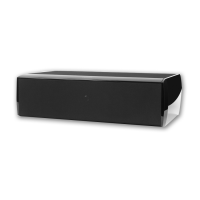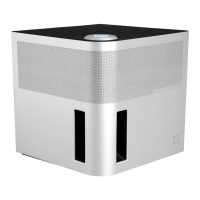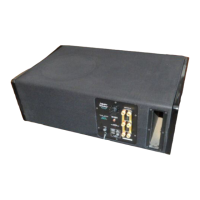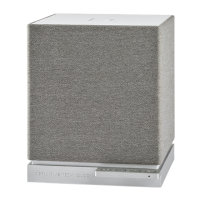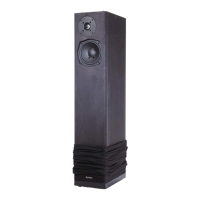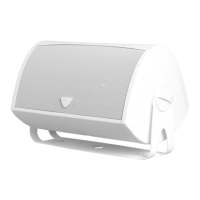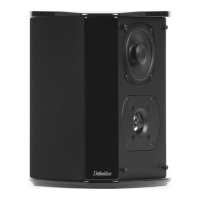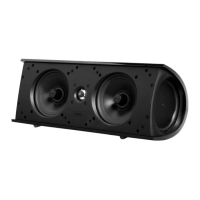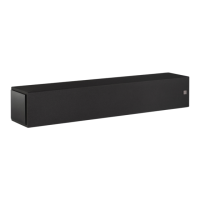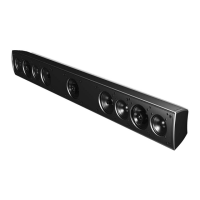Positioning Your Speakers
Unpacking Your
CS·8040HD
Your
new
CS
Series speaker
is
designed to add clarity
and
focus to the vocal
range
and
extend
the
musical image
of
your
home
theater.
To
optimize its
performance, please follow these simple guidelines. Although the following
recommendations will usually yield
the
best results, whatever sounds best to
you
is
correct.
Figure 3 -
Connecting
Speaker
to
Amplifier
Use
the manual speaker setup functions
in
your receiver
to
set speaker
configuration, speaker distance
and
channel balance. Consult your receiver's
or processor's manual to learn
how
to access
and
use
the
setup menus.
Set
center speaker
to
"small" with the crossover point set at 80Hz.
if
you experience
any
difficulties with your
CS
Series Speaker, try
the
suggestions
below. If you still have problems, contact your Definitive Technology Authorized
Dealer for assistance.
Troubleshooting
All
Dolby/DTS
multi-channel
receiver/amplifiers
feature
a
dedicated
channel
for
a
center
speaker.
Consult
your
receiver's
owner's
manual
for
the
appropriate
connection
procedure.
I~
~
I
-
R61eive,/Amptlfier
Speaker
Setup:
Small,
crassover
al
80Hz
L R C
SR
SL
+
OOGOO
-
001
00
A
Center
Channel
Speaker
should
be
placed
as
close
to
the
center
of
your
television
as
possible with-
out obstructing
your
view.
or
below
above
1-2'~!
(2.5-5 em)
II
~r!'lJ~
II
Please
Inspect
For
Shipping
Damage
Each loudspeaker leaves our plant
in
perfect condition. Any visible or concealed
damage most likely occurred
in
handling after it left our plant
and
should be
reported
at
once
to
your Definitive dealer or the delivery company
that
delivered your loudspeaker. Please unpack your system carefully. Save all cartons
and
packing materials
in
case
you
move or need to ship your system. Record
the
serial number found
on
the back
of
the
Center Channel
in
the Notes section of
this owner's manual.
Figure 1 -
Positioning
CS
Series
Center
Channel
To
receive
the
full
benefit
of
the
bass
radiators
built
into
your
CS
Speaker
leave
at
least 1-2" (2.5-5
cm)
of
space
between
the
top
of
the
speaker
and any
surface.
Connecting Your Loudspeakers
Figure 2 -
Wiring
and
Polarity
1.
Audible
distortion
when
the speakers are playing
at
loud levels
is
caused
by
driving (turning up) your receiver
or
amplifier louder
than
the
receiver or
the
speakers are capable
of
playing. Most receivers
and
amplifiers
put
out
their full-rated power well before
the
volume control
is
turned all the way
up, so
the
position of
the
volume control
is
a poor indicator
of
its power
limit.
if
your speakers distort
when
you play
them
loud,
tum
the
volume down!
2. If you experience a
lack
of
bass,
it
is
likely
that
one
speaker
is
out
of phase
(polarity) with
the
other speakers
in
the system
and
needs
to
be rewired
paying closer attention
to
connect positive to positive; negative to negative
on
both
channels. Most speaker wire has some indicator (such as color-
coding, ribbing or writing)
on
one
of
the
two conductors to help you main-
tain consistency. It
is
essential to connect
both
speakers
to
the
amplifier
in
the same way (in phase).
3.
Make sure all your system interconnects
and
power cords are solidly
connected.
4.
Check
that
no
foreign objects or liquid has entered
the
speaker cabinet.
Strip
1/4"
(6mm)
wire.
Identify
markings
on
wire
and
assign
+/-.
Re<eiver/Amplilier
'--
f--
I
nl
1.
Unsaew
binding
post
and
insert
wire.
Ensure
that
the
speaker
is
always
con-
2.
TIghten
until
wire
is
secure.
nected
to
the
receiver
or
amplifier
+
to
+
and-to-.
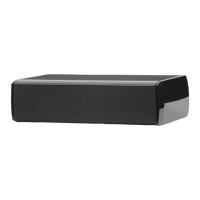
